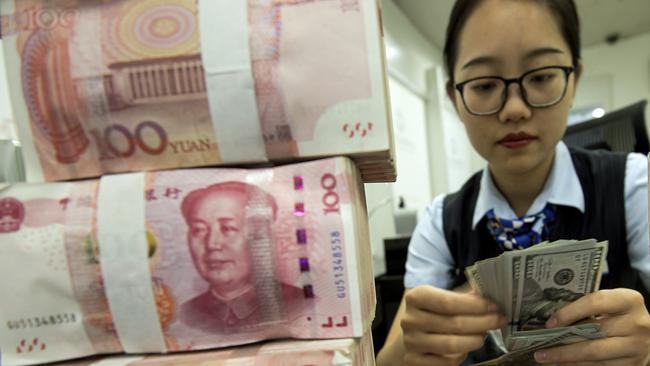Weaker yuan a new front in trade wars
The weakening of the yuan to the US dollar this week can be expected to have far-reaching ramifications for investors.

It’s rare that anything labelled as a psychologically important level in markets actually matters. But seven yuan to the US dollar — breached on Monday — does.
The weakening of the currency signals the opening of another front in the trade war, and brings with it big risks for investors.
The most obvious risk is also the least likely: that China will repeat the mistake of its 2015 devaluation, which led to heavy bets against the currency and took months to get under control.
Back then global investors soon switched from believing Beijing’s leadership were economic geniuses to thinking they were ignoramuses and stocks plunged.
Equity markets have again fallen sharply, although so far much less than the 11 per cent the S&P 500 was down at one point during August 2015. A better comparison may be to the trade battles of the past year. China is unlikely to have to burn through hundreds of billions of dollars of reserves again to fight speculators because it tightened exchange controls so much to deal with the 2015 problems.
Instead, the currency’s fall is part of the tit-for-tat tariff battle with the US, after President Donald Trump last week said punitive tariffs would be extended to the remaining $US300 billion ($440bn) of Chinese imports left out of previous rounds.
Because China exports far more to the US than it imports, it is hard for Beijing to match the tariffs. Devaluation is an alternative, which makes US exports more expensive in China, but also those from the rest of the world.
In purely economic terms, the market reaction to a move of less than 2 per cent in a major currency looks wildly overdone. Investors fled to the safety of gold and the yen, pushed German bund yields to a new low and 10-year Treasuries below 1.75 per cent. After all, the euro, yen and sterling have all had bigger one-day falls just since the start of 2017.
However, China had previously insisted it wouldn’t deliberately weaken its currency, and had defended the level of seven yuan to the dollar even as its economy slowed.
What looks like a change in strategy means a worsening of relations with the US, as shown by Mr Trump’s condemnation of the move as “currency manipulation”.
The People’s Bank of China governor, Yi Gang, insisted in a statement that the exchange rate won’t be linked to trade fights, and fluctuations were “driven and determined by market forces”. Were that true, the yuan would be weaker still, given investors are betting on further falls.
The PBoC has in the past moved the currency around to punish speculators, so it could well hold the yuan stable for a while or even push it back through seven to the dollar temporarily. But even just a natural reaction to the new tariffs should be a weaker currency, and it would be easy to allow the market to pull the yuan still lower against the dollar, hurting anyone who competes with Chinese exports.
Again, in purely economic terms, a somewhat weaker yuan isn’t that big a deal, because the stronger dollar had been dragging up the Chinese currency with it — the yuan’s fall on Monday only took it back to about where it stood in January against the euro.
But if this is a precursor of a big weakening to come, it could boost China’s trade surplus, which had been dropping for four years, turning China again into a deflationary drag on the world economy. At the same time, big exporters to China will find it harder to make sales, as prices in yuan will be higher.
Even worse is the further ramping up of the trade war from tariffs to other tools. The Chinese authorities have plenty of scope to hit US companies operating there.
There is still time to find a face-saving compromise on trade and stabilise markets. But investors are right to think the probability of a US-China deal is falling, and there’s a rising danger we are entering an era of deglobalisation that will rip apart stock prices.



To join the conversation, please log in. Don't have an account? Register
Join the conversation, you are commenting as Logout